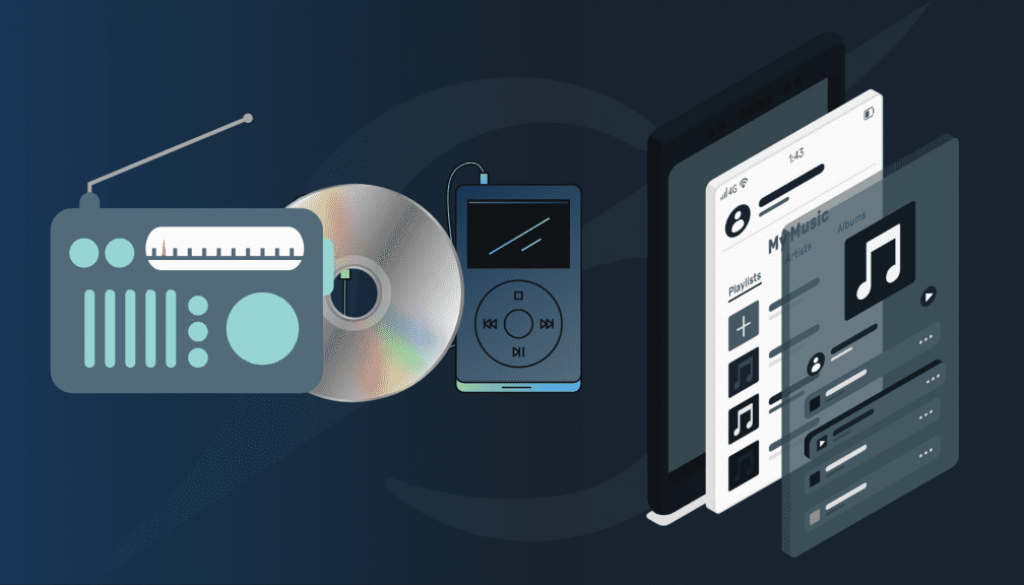Listening Through The Ages: From Analog To Internet
The telephone has been around ages now but conversations have shifted largely to texting. But even then voice calls have a charm that texts can never replace. There’s just something soothing about listening to the voice of a loved one, their laugh, the pauses between their sentences. Sound can be so comforting. Think of your favorite song and how it stirs you in the depth of your heart. Today we have it all at the click of a button. There was a time when listening to the voice of someone, anyone, without them being physically present couldn’t even be thought of.
So how did it all happen, where did it start? Let’s take a look at the evolution of audio technology through the ages-
The Analog Age
The Phonograph or Gramophone was the first stepping stone into audio communication
Also known as the first record player, the phonograph or more commonly known as the Gramophone appeared In 1877. Its invention is generally attributed to Thomas Alva Edison. The sound was recorded by a small needle that fits into a groove in the record. The needle attached to a horn through a diaphragm recorded voice by a spring-driven motor. As the record turned and vibrated, the sound was channeled out of the horn as playback.
Did you know that “Mary had a little lamb” are the first words spoken in the Phonograph by Edison? Who knew that a nursery rhyme could have such an impact.

He suggested various uses for the phonograph, such as letter writing, dictation, recording a family member’s voice, etc. In 1917, during the first World War, the Edison Company came up with a special model of the phonograph for the U.S. Army. Many Army units purchased them so that soldiers could have music to cheer them up when they were away from home. Edison also came up with phonographic books for blind people. Could this have been the first inspiration for audiobooks?
Radio’s history is rooted in the 2 World Wars
Radio cannot be thought of without music. While music is integral to radio it serves various other purposes. It is the first technology that brought audio entertainment to the mainstream. Radio’s rise is also intricately connected to the two World Wars. Transmission from aircraft to the base stations was key to communicating a soldier’s location. Spy stations or carrying out propaganda against enemy nations was all done through radio programs. The Nazis in Germany went door to door to check whether every household had installed a radio set to listen to their program and garner support for their cause.
In India, there are both private and government radio stations. The private, business-owned stations provide entertainment through music, short sketches, celebrity interviews, and even ghost stories as a part of late-night shows. While the Government station Akashvani and its branches broadcast news, long-form dramas or documentaries, special audience programs like farmer’s program, children’s stories along with the music.
Cassette Tapes became an easy and portable way to listen to music
Cassette Tapes didn’t appear on the audio scene until the 1970s. Now people could just feed in the cassette in their tape player and it’d play whichever song was recorded in it. It worked on the principles of Magnetic Tape recording or electromagnetism. A coil is wound around the tape head. When a current passed through, this coil positioned the magnetic material on the tape in line with the sound that was being recorded. Playback reversed the action. The magnetic material caused fluctuations in the signal flowing through the coil, and these fluctuations generated the sound.

These cassettes often had an A-side and a B-side. Once the songs recorded on one side stopped playing, one would have to physically remove the cassette and flip it so the rest of the songs played.
The Digital Age
CDs allowed for quick and easy replication of audio content
Enter the digital age. First came the CDs or compact discs. Music or any piece of audio got recorded as audio signals in a sequence and was then encoded onto the disc. People could burn CDs at home now. Who cared what the radio was playing when you could create your own mixtape. Remember those road travel compilations that you’d carefully handpick and burn onto the CD? CDs were a complete rage until the iPod or MP3 Player showed up.
Now they’re almost extinct. Even laptops don’t come with a CD drive anymore. CDs also had a lesser capacity than iPods or Mp3 Players.
iPod could fit thousands of songs with the option to update
It all began when the world entered the 21st Century in 2001. A man claimed that he could fit 1000 songs in his pocket. Behold the Apple iPod. iPod Nano, iPod classic, iPod touch, and countless other models flooded the market. It was a small device that could fit into your pocket, had buttons for forwarding or rewinding or selecting your choice of song from the menu. You could go back, delete and add new songs.

It became more of a status symbol, a marker of popularity. Every cool kid in school had an iPod. iPods lasted about a decade until Streaming services and better-designed mobile phones stole its thunder.
The New Age
Audio Streaming lets you access content in real-time without eating into storage space
Enter the internet. Streaming Platforms like Spotify, Audible, Amazon Music, Gaana, Saavn, Apple Music, and many more deliver the audio to your device through the internet. It’s just like radio except the content is already there and you have the convenience to access it at any given time.
Streaming platforms like Spotify, besides music, have given podcasting a push. In 2018 Spotify opened the podcast feature to their audience and by the end of the year number of podcasts, listening increased on the platform by 175%.
Podcasting lets you control your content at your own pace
Who hasn’t heard of podcasting? Anything from drama, to interviews, audiobooks, and discussions, can be a podcast. While it may have gained popularity a few years back but the term was coined by journalist Ben Hammersly when he wrote an article for The Guardian in 2004. He wrote about the boom in amateur radio, justifying that the elements necessary for podcasting were all at the tips of our fingers. Blogging was popular, production software was readily available and inexpensive, and MP3 players and iPods were the latest fads. He asked what to call it? “Audioblogging? Podcasting? GuerillaMedia?” and podcasting kind of stuck.
In 2005 big companies like Apple started recognizing the potential of this new medium. Apple came up with iTunes 4.9, their first update with native support for podcasts. The same year, George W. Bush became the first President to have delivered his weekly address in the form of a podcast. 2005 is also the year in which the New Oxford American Dictionary declared “Podcast” as the “Word of The Year”.
Today Podcasts are everywhere and it doesn’t take much to create one.
Podcasts have one teeny-tiny problem. The listeners can’t talk back. No problem. Audio chat rooms can take care of that.
Audio-only social media is steering in a new era of social communication
Audio chatrooms are platforms where listeners can interact with like-minded people and engage with the speaker and other listeners by talking back. Apps like Clubhouse, Discord, and Spoon are a few such platforms that are becoming increasingly popular. These platforms have the feature to type as well. These audio-based chatrooms are all the fad now. Celebrities and tycoons like Elon Musk host sessions on Clubhouse which see a plethora of listeners joining in. They satiate the pandemic-driven need for human connection and eliminate videoconferencing fatigue.
It is still in its early stages and an industry that’s still growing. As of February 2021, Clubhouse had 2 Million weekly active listeners.
Today audio is no longer limited to media content rather it has entered our personal lives. For example, Amazon’s Alexa not only provides information and entertainment but also carries out household chores by responding to voice commands. Audio notes and educational podcasts are becoming mainstream in new-age learning. Google aggressively promotes its voice search that makes information access easier to the underserved.
Similarly, we are spearheading the next evolution in audio content consumption. At Voyezr, we are integrating multiple audio content segments in one platform and creating a multi-functional super app! Listeners across geography and socio-cultural diversity will seamlessly access a diverse range of curated, premium, and self-produced audio content available in one place.
The way we consume audio has constantly been changing, with a constant human need to connect with our surroundings and ourselves through listening. We will always find a way to make that experience even more simulating.

Sayani is a voracious reader and the books she has read inspire her writing. She is currently pursuing her Master’s in Mass Communication from Jamia Millia Islamia. When she’s not going maniac about her studies she can be found playing fetch with her dog Tintin.
